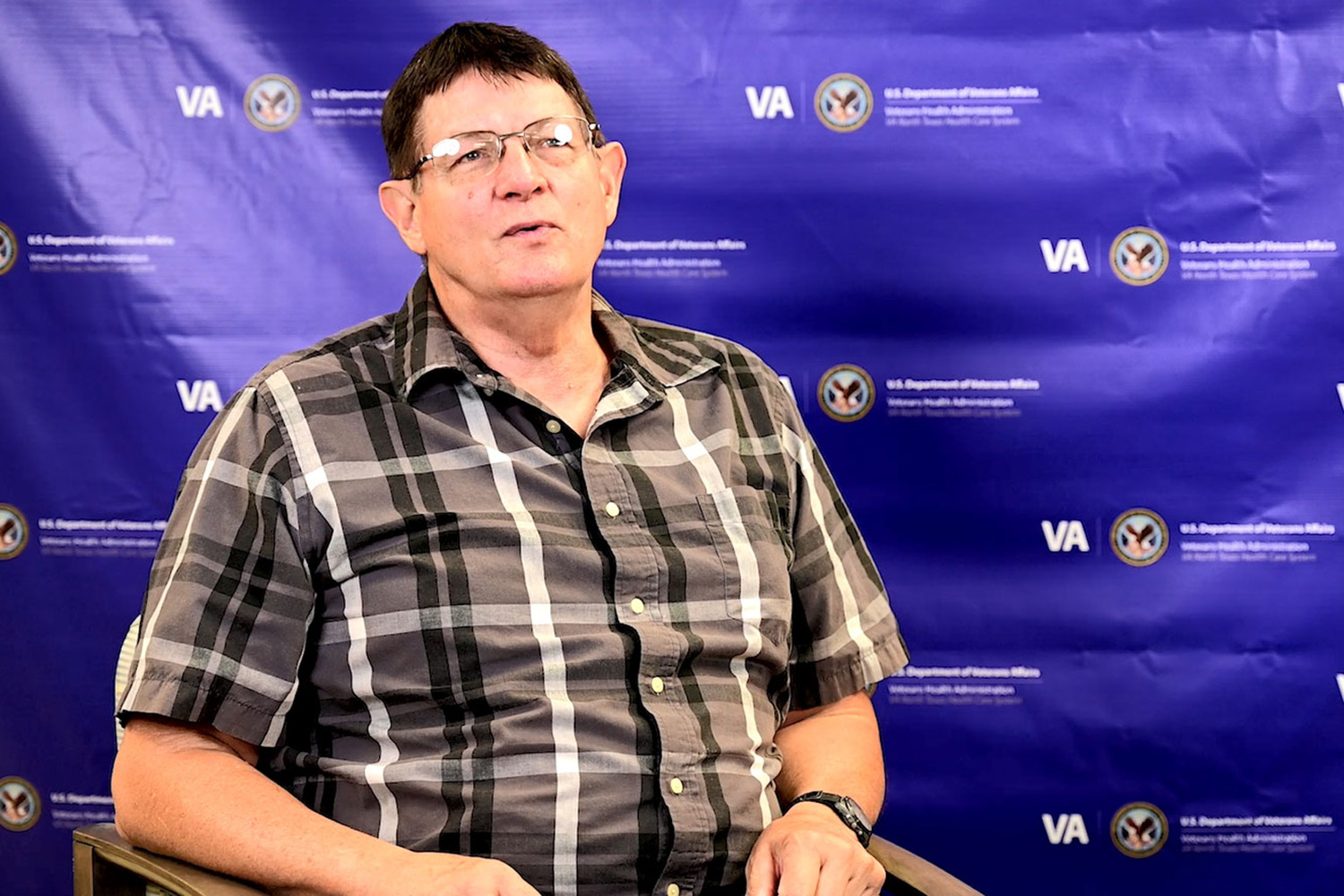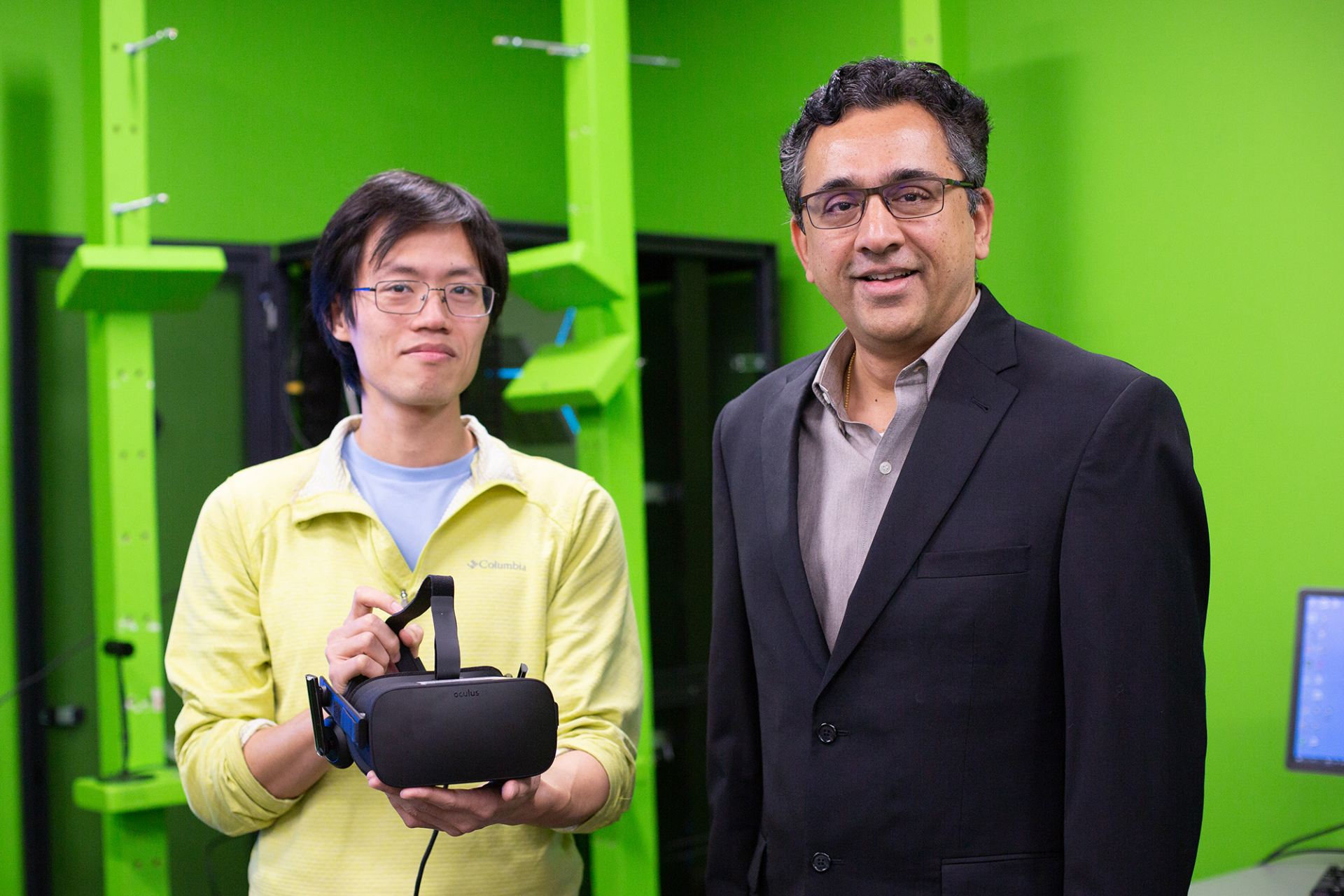Virtual Therapy Shows Real Promise for Managing Phantom Limb Pain

U.S. Navy veteran Dean Peterson has suffered from phantom limb pain ever since his lower left leg was amputated 16 years ago after a hunting accident. So, he was eager to volunteer for a clinical trial of a therapy to alleviate phantom limb pain developed by researchers at The University of Texas at Dallas and the Veterans Affairs North Texas Health Care System.
Phantom limb pain is believed to be caused by mixed signals to the brain after an amputation. The researchers’ therapy, called Mixed reality system for Managing Phantom Pain (Mr. MAPP), is designed to help the brain resolve the signals. Mr. MAPP is the result of years of research led by Dr. Balakrishnan Prabhakaran and in collaboration with the VA. Prabhakaran is a professor of computer science in the Erik Jonsson School of Engineering and Computer Science at UT Dallas and director of the Multimedia Systems Laboratory.
Prabhakaran, senior author, and the study’s co-authors described the feasibility of Mr. MAPP in an article published online Oct. 22 in Pilot and Feasibility Studies.
Mr. MAPP involves a laptop, camera and virtual reality (VR) headset. The system, which a small group of patients used in their homes during the four-week pilot trial, generates a virtual 3D model of the user’s missing limb. Wearing the VR headset, the user plays a series of games that involve using the virtual model of the missing limb to complete tasks such as stomping or bursting a bubble on the screen. The participants were veterans treated at the Dallas VA Medical Center.
“The whole idea is to fool your brain into actually seeing a leg and foot,” said Peterson, who lives near Sanger, Texas.
Peterson said the treatment reduced the pain that often keeps him up at night. The 67-year-old, who served in the Navy in the Philippines and in Vietnam, receives a limited supply of pain medication that does not completely manage his pain.
“By the time I was three weeks into the study, I realized the pain wasn’t bothering me as much at night. It was easier to fall asleep,” Peterson said. “I was impressed with it.”
“The whole idea is to fool your brain into actually seeing a leg and foot.”
Dean Peterson, a Navy veteran who used Mr. MAPP in a clinical trial
While the proof-of-concept study was limited to a handful of patients, the researchers are encouraged by the potential of the system to improve pain and physical functioning outcomes in patients with limb loss and phantom pain. They have a provisional patent and hope to conduct further clinical trials and license the technology to bring the product to physical-rehabilitation providers and consumers.

“The feedback has been heartening. One of the patients said he played this game instead of taking pain medication,” Prabhakaran said.
Researchers hope that Mr. MAPP can become an alternative to opioid use and that the technology can be applied to other conditions that cause pain.
A classic treatment for phantom limb pain has been mirror box therapy, which uses a box and a mirror to create the illusion of the missing limb, but it is not optimal, Prabhakaran said, and typically provided only in a health care setting. By using VR and augmented-reality technology, which overlays real-world objects into virtual settings, Mr. MAPP improves on this treatment, and the therapy can be performed at home using a laptop.
Peterson said he had tried mirror box therapy in the past without success. He said the virtual leg that Mr. MAPP generated was easier to use and more effective.
“It was a pretty cool feeling. It felt like I had two feet, and that was cool enough that I wanted to stick with it,” said Peterson, who hopes the treatment becomes available to consumers.
UT Dallas co-authors of the study include Kanchan Bahirat PhD’18, who worked on the project as a doctoral student and now works at Simbe Robotics Inc., and Yu Yen Chung, a computer science doctoral student.
Other contributors include corresponding author Dr. Thiru Annaswamy, formerly with UT Southwestern Medical Center and the Dallas VA and recently named chair of physical medicine and rehabilitation at Penn State Health Milton S. Hershey Medical Center; Dr. Gargi Raval, assistant professor of physical medicine and rehabilitation at UT Southwestern; and Tri Pham, a UT Southwestern medical student.
Source | UT Dallas News Center | Written by Kim Horner
ABOUT THE UT DALLAS COMPUTER SCIENCE DEPARTMENT
The UT Dallas Computer Science program is one of the largest Computer Science departments in the United States with over 4,000 bachelors-degree students, more than 1,010 master’s students, 140 Ph.D. students, 52 tenure-track faculty members, and 42 full-time senior lecturers, as of Fall 2021. With the University of Texas at Dallas’ unique history of starting as a graduate institution first, the CS Department is built on a legacy of valuing innovative research and providing advanced training for software engineers and computer scientists.




